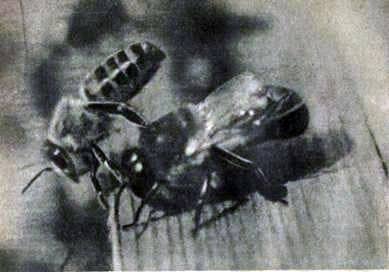
Honeycombs, freed from honey, are saved until the next honey crop in the sewers – special unheated rooms that are inaccessible to bees. In large beekeeping farms, where there are a lot of honeycombs, sotohranilischa are equipped with ventilation devices and cooling systems.
Honeycomb is stored in cases and shops, which are stacked on top of each other from floor to ceiling. If cracks are formed between the extensions, they are eliminated. Stands are covered with a frequent metal net. And ventilation, and low temperatures, and finally, grids are needed in order to prevent or neutralize the wax moth – the most dangerous pest of honeycombs. It is very prolific. The butterfly of a large wax moth during its short life (it lives less than a month) lays up to three thousand eggs.
Gluttonous and very mobile caterpillars of moths feed on wax and protein substances of cocoons. They make moves in honeycombs and entangle them with cobwebs. During the fall or spring, the moth can destroy the entire cellular stock. Mole is afraid of draft and cold. They are just created in sotohranilischah.
The wax mole penetrates into the hives of weak families, it quickly multiplies and destroys honeycombs. The family is dying. Strong families of butterflies and caterpillars moths kill and throw away.
Eggs of wax moths are more often found on bad old honeycombs. Therefore, such unsuitable honeycombs are re-heated to wax.
Usually, steam waxes of factory production are used. But the trimming that remains after the printing of the honeycomb frames, is re-heated on a solar wax-up. In it, thanks to solar heating, a high temperature is created, at which the wax melts. By drop, it flows down in the trough, where it freezes. Wax-kapanets of the highest quality.
A solar wax-up is a piggy bank of an apiary. After all, wax is a jewel. Wax pieces and crumbs from cleaning the frames to the hive, from the alignment of the honeycombs, remote unnecessary extensions, cut pieces of drone honeycombs – all this goes to the solar wax-up. You look: there is a kilogram of wax. The solar wax-up is an obligatory accessory of the apiary.
Bees on a sunflower.
When the sunflower blossoms, like a thousand hot suns burning down to the ground. He occupies huge areas in the North Caucasus and in the Central Chernozem zone, in Ukraine and in the Volga region, in the Altai and in Kazakhstan.
This plant gives off nectar only at high temperatures. In a basket of sunflowers up to two thousand nectariferous flowers. Therefore, on one inflorescence often several bees work simultaneously. And they have enough to do. The nectar is in the depth of the flower, it must be got, and besides, along the way, collect the pollen. There are a lot of her here. Long, more than a month, sunflower blossoms – the representative of the late main bribe. Bees work from morning till evening, often they do not even have time to return home before sunset and spend the night in the field.
On some hot days after the rain, the control hive weighs 10-12 kg. However, an increase of 3-4 kg per day, as often happens in the midst of flowering sunflower, is considered good and quite satisfactory to beekeepers. “From a sunflower,” they say, “it’s not from lime trees, but it’s still sticking.” Sunflower honey is golden-light, like the flowers themselves, with a faint scent.
Honey bees are the main pollinators of sunflower. They greatly increase its harvest.
Как почистить соты. Рецепт кваса из хрена.
Young Beekeeper